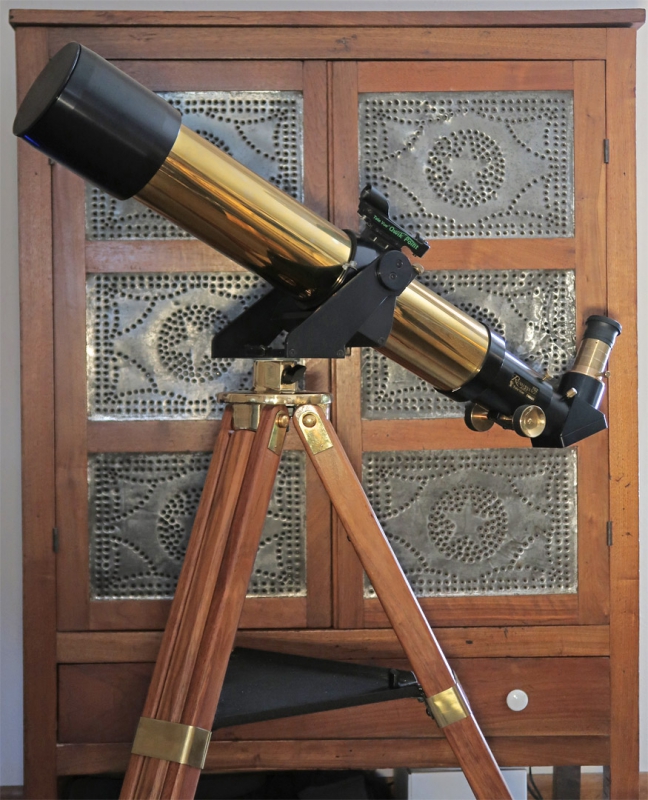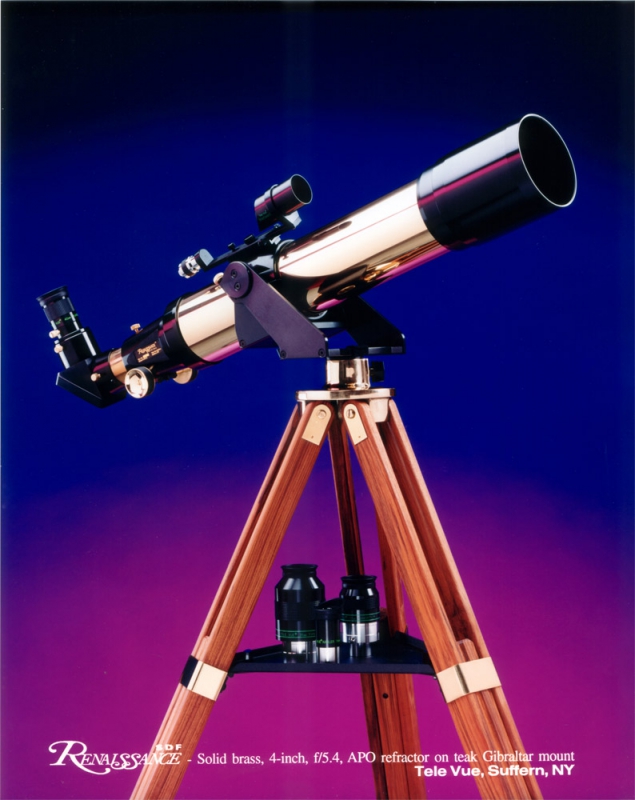Tele Vue Scope Renaissance! (Part II)

Vic Bradford has owned a brass Renaissance telescope since 2006, about 20 years after he first saw Al Nagler show one at a Riverside Star Party. He regrets not owning one sooner as “the scope uniquely merges the beauty of form and function”. We’ve reprinted some excerpts below from a treatise he sent us on caring for the brass on his Renaissance telescope and brass fittings on his matching Tele Vue Gibraltar mount. He offers a caveat to the reader: “you may find these suggestions overkill and much can be said for simply leaving brass alone so it can develop a nice patina. Like any other fine equipment, though, it benefits from good care and research.”
Household and outdoor dust can contain acids and ammonia, which may pit or etch the brass surface, so I would suggest frequent (very) light dusting with something like a “California [car] duster” or microfiber cloth. I try to do this once a week. Removing dust from joints or hard-to-reach areas can be done with a boar-bristle brush. Even better, protect the scope with a cotton bag or a case when it isn’t in use.
put yourself into a good and patient mood
Before polishing a soft material like brass, put yourself into a good and patient mood, use enough light to see how the surface is doing, find a good ventilated area, and go in a straight line rather than a circle to make any scratches less obvious. Polishing anything that requires some care is best done when it is relaxing for you, not when you are in a hurry.
Practice on an expendable brass piece first. Even here, the alloy composition of your practice piece may not be identical with your valued piece, so start with an area at the bottom of your valued piece so you won’t see it as much if it doesn’t work, and evaluate the area before going further.
I would suggest a microfiber cloth for applying polish (some suggest 100% cotton, but I find cotton flattens out and traps more dust). Microfiber cloths are so cheap that you can use a separate cloth for polishing, waxing, and buffing.
Theoretically, polish will be abrasive enough to remove surface contaminants but not abrasive enough to scratch your scope. In actuality, no polish will do this, and abrasive dust is going to settle on your cloth and scope surface anyway (even if you carefully dust the surface first). Therefore, any time you polish brass, you are going to scratch it. Accept these scratches in a brass item as “character marks,” sort of like gray hair.
To prevent polish from running beneath the housings, and to prevent any possibility of staining the anodized housings, I will seal them with a rubber band placed between the housing and the brass at both ends, and put some electrical tape on the anodized housing.
Most polishes contain a chemical that reacts and bonds with contaminants so they can be removed with light pressure, but will not be acidic enough to etch the brass surface. If you look on the internet you will find a vast number of methods for polishing brass, from egg whites to ketchup to automotive cleaner waxes. Heavy fingerprints, hard water stains, chemical stains, etc. might etch into the metal and should ideally be removed quickly with a light polish. I have also used various non-abrasive paintwork cleansers or detailers to remove these items (you can find some suggestions at carcareonline.com or other good websites).
Brasso metal polish, which Tele Vue recommends, seems good enough. The ammonia and acids in Brasso may not be good in the long-term, but the polish is useful in the short-term.
Wax also helps prevent fingerprint damage at star parties, where people often want to touch your beautiful scope, and keeps you in a good mood when they do.
Unlike polishes, pure waxes have no abrasives and form a thin protective layer over the brass. Among the benefits of wax is prevention of stains, dew marks, etching and makes wiping off dew and dust buildup easier. Wax also helps prevent fingerprint damage at star parties, where people often want to touch your beautiful scope, and keeps you in a good mood when they do. Wax seems to deepen the color of the brass, which you may not like.
Like waxing a car, it’s best with a freshly dusted surface, a microfiber cloth that has not been used to apply an abrasive polish, light pressure, and light buffing to remove wax residue.
Liquids may penetrate or run onto optics so paste waxes seem best. I suggest not using a cleaner wax, since these can scratch the metal, but instead using a pure protective Carnauba wax like Blitz Wax or Zymöl.
I would also file or polish the edges of your clamshell mount, and place a small piece of electrical tape on the edges, to prevent the mount from gouging the brass.
Don’t coat your scope! Tele Vue and others strongly recommend against using any semi-permanent, adhesive polyurethane or plastic coatings, or even nail polish, lacquers,or sprays. These will eventually peel and degrade, and then you will have an uneven and unsightly finish that cannot be corrected. “Protective” semi-permanent liquids, ammonia compounds, or some polishes may seep into micro-cracks and cause discoloration or cracking.
The best way to make a lot of scratches is to try removing one.
The best way to make a lot of scratches is to try removing one. If you choose to ignore this advice, start trying to remove the scratch with the least abrasive material first and then move up until the scratch goes away (you hope). Brass is not like car paint or wood, where you can gradually sand or buff your way out of trouble, unless you can access professional equipment.
Preventing scratches can be a challenge when moving the scope through doorways so I would suggest clearing a path, using microfiber gloves (so it doesn’t pick up chemicals from my hands), covering the scope with a blanket, holding doors open, and other common sense items.



